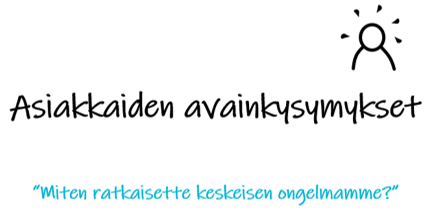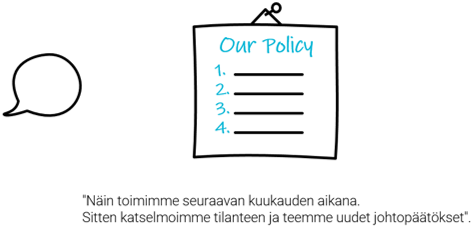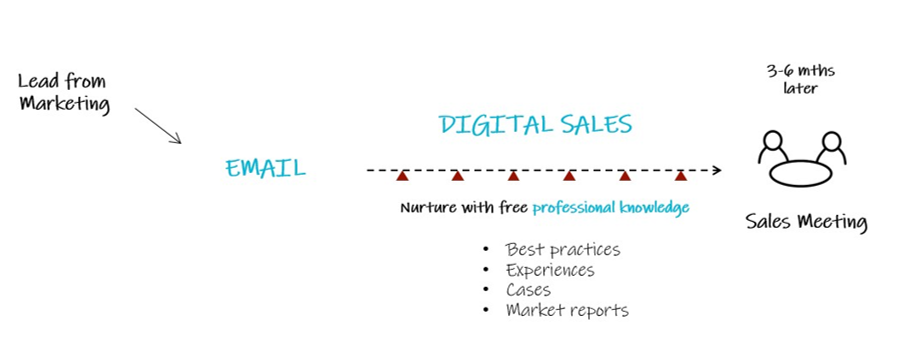Selkeä omistajatahto
Nyt puhutaan omistajan tahtotilasta, mitä on selkä omistajatahto? Vieraanani haastateltavana on rakas kollegani Veli-Matti Savo Turusta! Tämä teksti on videohaastattelun litterointi.
Omistajatahto

Kuvassa olevat gubbet ovat omistajia. Jos yrityksessä on vain yksi johtaja, silloin omistajatahto on tietenkin helpompi määrittää. Monissa yrityksissä kuitenkin on useampi johtaja, jolloin omistajatahto pitää käydä läpi koko porukan kanssa.
Markus: Eikö omistajatahto ole käyty läpi silloin, kun yritys on perustettu? Tarvitseeko se päivitystä?
Omistajatahdon päivitys

Veli-Matti: Ehdottomasti tarvitaan päivitystä. Varsinkin, jos esimerkiksi liiketoimintaympäristö on muuttunut. Yleensä liiketoimintaympäristö on muuttunut sen jälkeen kun yritys on perustettu, kun se on kasvanut ja lähtenyt uusiin bisneksiin. Päivitystä täytyy tehdä! Ajantasainen omistajatahto ei tosiaankaan ole itsestäänselvyys tällä hetkellä.
Markus: Avaa meille, mikä se omistajatahto on.
Omistajatahdon sisältö

Markus: Eikö tämä ole melko herkkä asia? Siellä voi olla jopa pelkoa siitä, että kun tätä kasaa lähdetään kaivamaan, niin tulee vain pahempi haju.
Veli-Matti: Se on monesti niin, että omistajat joutuvat päättämään miten mennään. Se tarkoittaa sitä, että kun tehdään päätöksiä, niin myös sitoutuu siihen. On tavallaan helpompi olla sellaisessa tilanteessa ettei kirjata omistajatahtoa. Mutta silloin yhtiö ei menesty optimaalisesti, jos omistajatahto ei ole selkeä. Omistajatahto täytyy myös kirjata ylös. Vasta kun omistajatahto on kirjattu, se on oikeasti olemassa.
Omistajatahdon kirjaaminen

Veli-Matti: Se on todella kova paikka, ja on hikinen paikka kaikille omistajille aidosti kirjata tahto. Mutta kaikki pääsevät sitä kommentoimaan ennen kuin se on lopussa yhteen pahviin kirjoitettu. Olen nähnyt sen upean fiiliksen mikä syntyy sitten, kun se on olemassa. Kaikki ovat tyytyväisiä, myös ne, jotka ovat olleet epävarmoja siitä alussa.
Markus: Niin, ja jännitteet häipyvät! Toimitusjohtajallakin on paljon helpompi olla, eikö niin?
Veli-Matti: Juuri näin, erittäin tärkeä pointti.
Roolit arjessa

Veli-Matti: Pahimmillaan siten, että omistajat antavat erilaisia viestejä arjessa. Sen takia tämä omistajarooli arjessa täytyy spesifioida: Mitä se tarkoittaa, jos omistaja on töissä yrityksessä? Hassua on se, että monet omistajat ovat sekä toimitusjohtajia, että hallituksen puheenjohtajia. Se on tavallaan turhaa, koska siitä saa enemmän irti kun löytyy joku tietty rooli, missä omistaja on parhaimmillaan.
Markus: Entä lähipiirin rooli, ketkä ovat lähipiirissä.
Veli-Matti: Omistajan lähipiiri on lähimmäiset. Sekin asia on hyvä kirjata ns. hyvän sään aikaan. Kun lapset ovat pieniä, kaikki on ok. Mutta kun he ovat työikäisiä, tulee ongelmia, jos siitä ei ole sovittu etukäteen.
Markus: Niin siis, että he tulevat sinne töihin, vaikkei tarvitsisikaan?
Veli-Matti: Niin, jos he pystyvät tuomaan oman panoksensa yritykseen, se on hieno juttu. Mutta yrityksen kannalta on aina löydettävä se paras ratkaisu. Ja silloin toimitusjohtaja päättää ketä otetaan töihin.
Markus: Entä hallituksen rooli arjessa?
Veli-Matti: Hallituksen rooli näkyy arjessa erityisesti toimitusjohtajan kautta. Monesti kaikki omistajat ovat hallituksessa, ja se on pienessä yrityksessä turhaa. Hallituksen jäsenenä joutuu kantaa erilaista vastuuta kuin omistajana, ja kaikki eivät lähtökohtaisesti ole sopivia siihen, eikä kaikkien tarvitse siis olla hallituksessa.
Markus: Siinähän se tuli. Kerro vielä vähän vallasta.
Selkeä valta

Yllä olevan kuvan oikeassa yläkulmassa on hyvä merkki: Omistajan täytyy antaa täysi valta hallitukselle, jotta yrityksestä ja toiminnasta saa eniten irti. Hallitus johtaa toimitusjohtajaa. Muussa tapauksessa ollaan vasemmassa alareunassa punaisella alueella, jolloin toimitusjohtajalla on kaikki valta – ja niinhän ei pidä olla.
Markus: Kukaanhan ei voi ottaa valtaa omistajilta, eikö niin?
Veli-Matti: Näinhän se on, tavallaan sitä pelätään: Annetaanko hallitukselle vastuuta, lähteekö se käsistä? – Vastaus: Ei missään nimessä, omistaja saa aina vaihtaa hallituksen. Ja kirjaamiseen vielä sen verran, että omistajatahto ei ole julkinen asiakirja, vaan vain hallituksen omassa käytössä.
Markus: Taivuta nyt rautalangasta – miksi vallan pitää olla tasapainossa, eli miksi hallituksella pitää olla se aito valta, mikä sille kuuluu?
Veli-Matti: Jos hallituksella ei ole valtaa, silloin valta on toimitusjohtajalla. Silloin omistajan valta on vähäisempi. Kun omistajatahto luetaan hallituksessa, hallitus valvoo, että omistajan tahto tulee todeksi. Silloin hallitus on ainut instanssi, joka pitää omistajan oikeuksista kiinni.
Toimitusjohtaja onnistuu

Markus: Silloin hän voi aidosti ja paljon helpommin olla kapteenina. Eli jos omistajatahto on kohdallaan, niin strategian voi laittaa tulille, eikö se olekin se pointti?
Veli-Matti: Se on juurikin näin. Kun lähdetään rakentamaan liiketoimintastrategiaa, omistajan tahto täytyy olla ensin selvillä.
Markus: Kiitos Veli-Matti haastattelusta! Tämä oli mahtava juttu.
Laita strategia tulille! 🔥
Viimeaikaisia blogeja
Markus Westerlund on Rdigon perustaja ja strategiakonsultti. Hän on 25 vuoden aikana fasilitoinut toistasataa strategiaprosessia, ensiksi asiakkuusstrategioita vuosina 1996-2007 Vectia Oy:n toimitusjohtajana ja vuodesta 2007 liiketoimintastrategioita Rdigossa. Corporate uransa hän on teki Nokian palveluksessa ensin tietoliikennepuolella ja sitten IT puolella Nokia/ICL Datassa. Markus on DI.
Rdigo on senioripartnerien strategia boutique. Erikoisuutena on laajasti osallistava strategiaprosessi tehokasta digifasilitointia hyödyntäen, nykyajatusten voimakas haastaminen, strategian yksinkertaistaminen ja ketterä strategian implementointi.
















































 Jos haluat pysyä ajan tasalla uusimmista keisseistä ja ahaa-elämyksistä, liity
Jos haluat pysyä ajan tasalla uusimmista keisseistä ja ahaa-elämyksistä, liity 













































